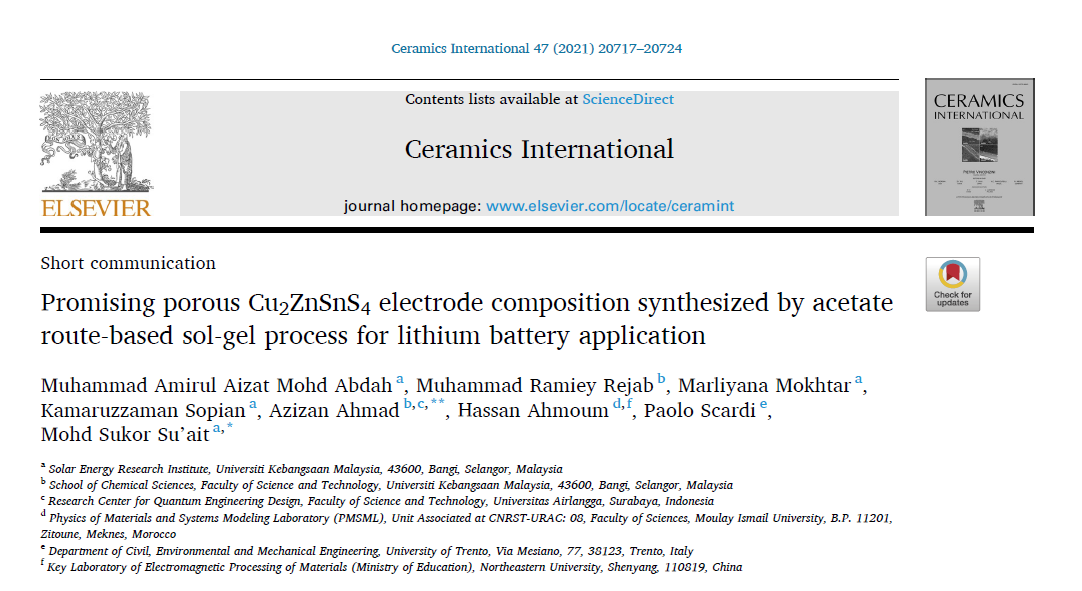October 19, 2021
Last Publication:
Effects of Grain Size on the Thermoelectric Properties of Cu2SnS3: An Experimental and First-Principles Study
Ketan Lohani, Himanshu Nautiyal, Narges Ataollahi, Krishnendu Maji, Emmanuel Guilmeau, and Paolo Scardi
https://doi.org/10.1021/acsaem.1c02377
© 2021 The Authors. Published by American Chemical Society - Applied Energy Materials
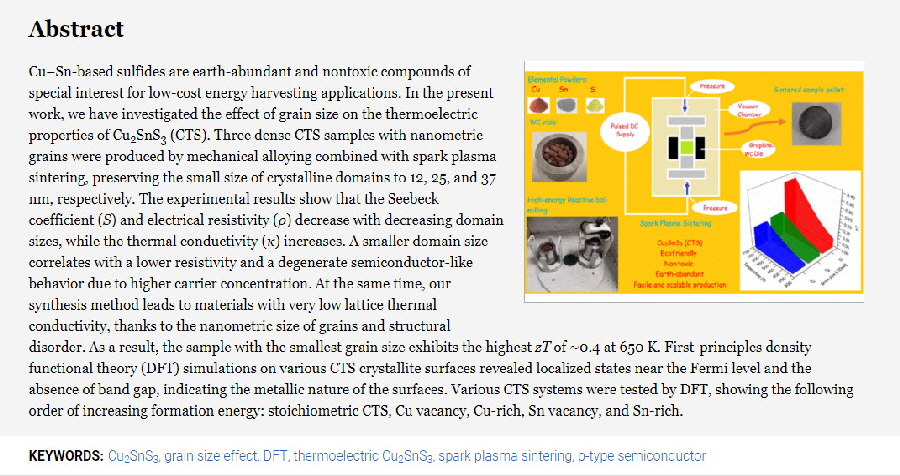
September 7, 2021
Eleonora Isotta Doctoral Thesis dissertation:
Title: Nanostructured thermoelectric kesterite Cu2ZnSnS4
Report: To support the growing global demand for energy, new sustainable solutions are needed both economically and environmentally. Thermoelectric waste heat recovery could contribute by increasing industrial process efficiency, as well as powering stand-alone devices, microgenerators, and body appliances.
The structural complexity of quaternary chalcogenides provides an opportunity for engineering defects and disorder, to modify and possibly improve
specific properties. Cu2ZnSnS4 (CZTS, often kesterite), valued for the abundance and non-toxicity of the raw materials, seems suited to explore these
possibilities, as it presents several structural defects and polymorphic phase transformations.
The aim of this doctoral work is to systematically investigate the effects of structural polymorphism, disorder, and defects on the thermoelectric properties of CZTS, with particular emphasis to their physical origin.
A remarkable case is the order-disorder transition of tetragonal CZTS, which is found responsible for a sharp enhancement in the Seebeck coefficient due to a flattening and degeneracy of the electronic energy bands. This effect, involving a randomization of Cu and Zn cations in certain crystallographic planes, is verified in bulk and thin film samples, and applications are proposed to exploit the reversible dependence of electronic properties on disorder. Low-temperature mechanical alloying is instead discovered stabilizing a novel polymorph of CZTS, which disordered cubic structure is studied in detail, and proposed deriving from sphalerite-ZnS. The total cation disorder in this compound provides an uncommon occurrence in thermoelectricity: a concurrent optimization of Seebeck coefficient, electrical and thermal conductivity.
These findings, besides providing new and general understanding of CZTS, can cast light on profitable mechanisms to enhance the thermoelectric performance of semiconducting chalcogenides, as well as delineate alternative and fruitful applications.
September 7, 2021
Ubaidah Syafiq bin Mustaffa Doctoral Thesis dissertation:
Title: Alternative uses of CZTS thin films for energy harvesting
The search for renewable energy resources and ways to harvest them has become a global mainstream topic among researchers nowadays, with solar cells and thermoelectric generators among the energy harvesting technologies currently being researched in vast. CZTS (Cu2ZnSnS4), a p-type semiconducting material initially researched to replace copper indium gallium selenide (CIGS) as the light absorbing layer in thin film solar cells, was studied in this doctoral work for alternative uses in energy harvesting. This work aims to systemically investigate the prospects of CZTS to be used as hole transport layers and thermoelectric generators.
CZTS thin film was successfully fabricated using a versatile approach involving hot-injection synthesis of CZTS nanoparticles ink followed by spin coating and thermal treatment. Results obtained revealed the possibility to fine control CZTS thin film fabrication based on ink concentration and spin. Besides that, thermal treatment temperature was found to affect the film’s overall properties, where an increase in thermal treatment temperature improved the degree of crystallinity and electrical properties. In addition, a phase change going from less stable cubic and wurtzite structures to a more stable tetragonal structure was also observed. Furthermore, CZTS was found to be a good candidate to replace the commonly used organic hole transport layer in perovskite solar cells, with potentials in improving performance and stability. In addition, CZTS also possessed good transport properties to be a potential p-type material in a thermoelectric generator, with the preliminary performance of fabricated CZTS/AZO thermoelectric generator showing a maximum power output of ~350 nW at ~160 K ΔT.
These findings provide new perspectives for CZTS in energy harvesting applications, despite the struggle in its development as the absorber layer in thin film solar cells. Besides providing a deeper understanding of CZTS and its vast possibilities in energy harvesting applications, promising future research stemming from this work is also limitless, reinventing ways in material studies, in search of alternative applications which may be of benefit.
May 28, 2021
Thermoelectric properties of CZTS thin films: effect of Cu-Zn disorder
Isotta, E; Syafiq, U; Ataollahi, N; Chiappini, A; Malerba, C; Luong, S; Trifiletti, V; Fenwick, O; Pugno, N M; Scardi, P
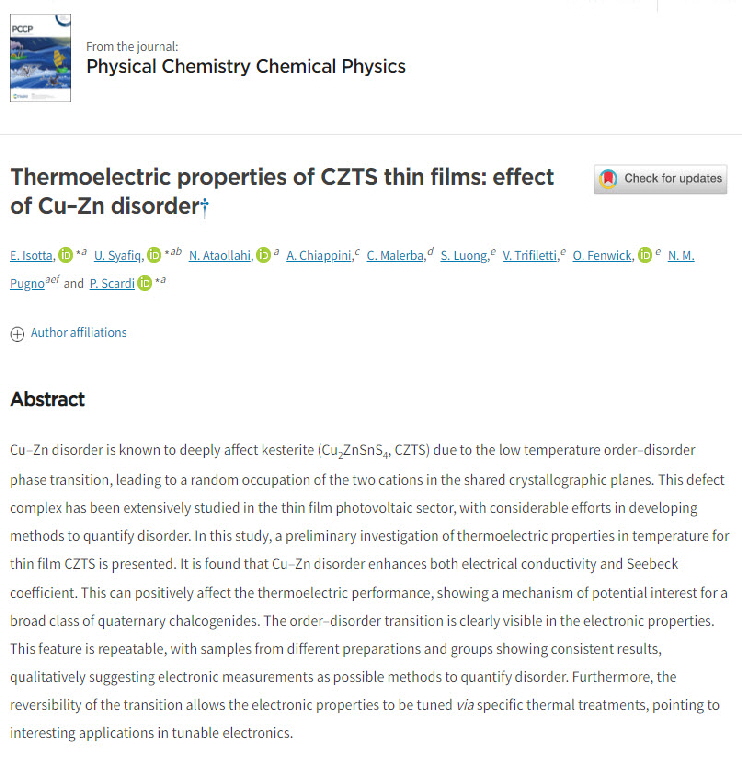
24 Feb, 2021
Order Parameter from the Seebeck Coefficient in Thermoelectric Kesterite Cu2ZnSnS4
Isotta, Eleonora; Mukherjee, Binayak; Fanciulli, Carlo; Pugno, Nicola M.; Scardi, Paolo - TMS 2021: 150th annual meeting & exhibition supplemental proceedings
CHAM, CH-6330, SWITZERLAND http://hdl.handle.net/11572/298942
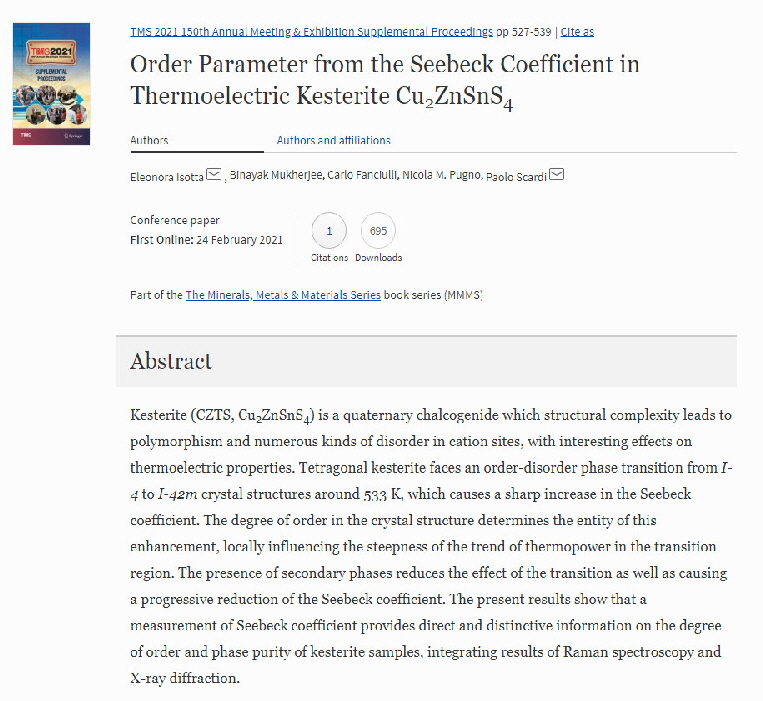
6 Jan, 2021
Experimental and Ab Initio Study of Cu2SnS3 (CTS) Polymorphs for Thermoelectric Applications / Lohani, Ketan; Nautiyal, Himanshu; Ataollahi, Narges; Fanciulli, Carlo; Sergueev, Ilya; Etter, Martin; Scardi, Paolo. - In: JOURNAL OF PHYSICAL CHEMISTRY. C. - ISSN 1932-7447. - 2020(2020), pp. 1-11. http://dx.doi.org/10.1021/acs.jpcc.0c09139

3 Mar, 2021
Correction to “Experimental and Ab Initio Study of Cu2SnS3 (CTS) Polymorphs for Thermoelectric Applications” / Ketan Lohani, Himanshu Nautiyal, Narges Ataollahi, Carlo Fanciulli, Ilya Sergueev, Martin Etter, and Paolo Scardi J. Phys. Chem. C 2021, 125, 1, 178−DOI: 10.1021/acs.jpcc.=c=9139
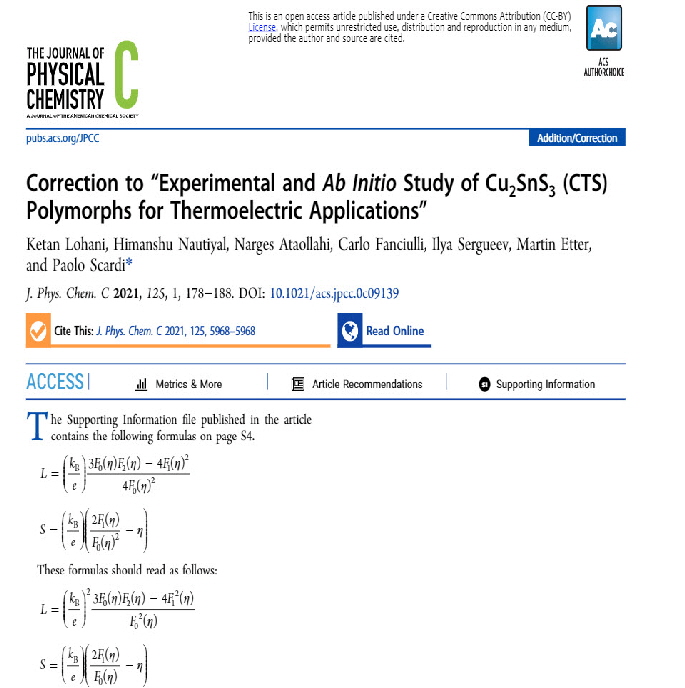
12 Mar, 2021
Diffraction line profiles from polydisperse crystalline systems. Corrigenda / Scardi, Paolo. - In: ACTA CRYSTALLOGRAPHICA. SECTION A, FOUNDATIONS AND ADVANCES. - ISSN 2053-2733. - 77:Pt 3(2021), pp. 232-232. http://dx.doi.org/10.1107/S2053273321002813
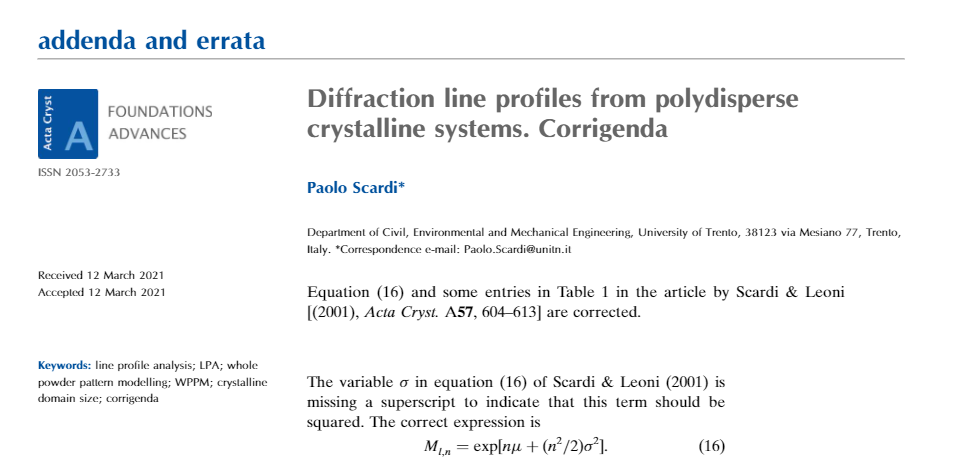
1 Mar, 2021
Effect of oxygen adsorption and oxidation on the strain state of Pd nanocrystals, Binayak Mukherjee, Alberto Flor & Paolo Scardi, Department of Civil, Environmental and Mechanical Engineering , University of Trento http://dx.doi.org/10.1016/j.apsusc.2020.148508
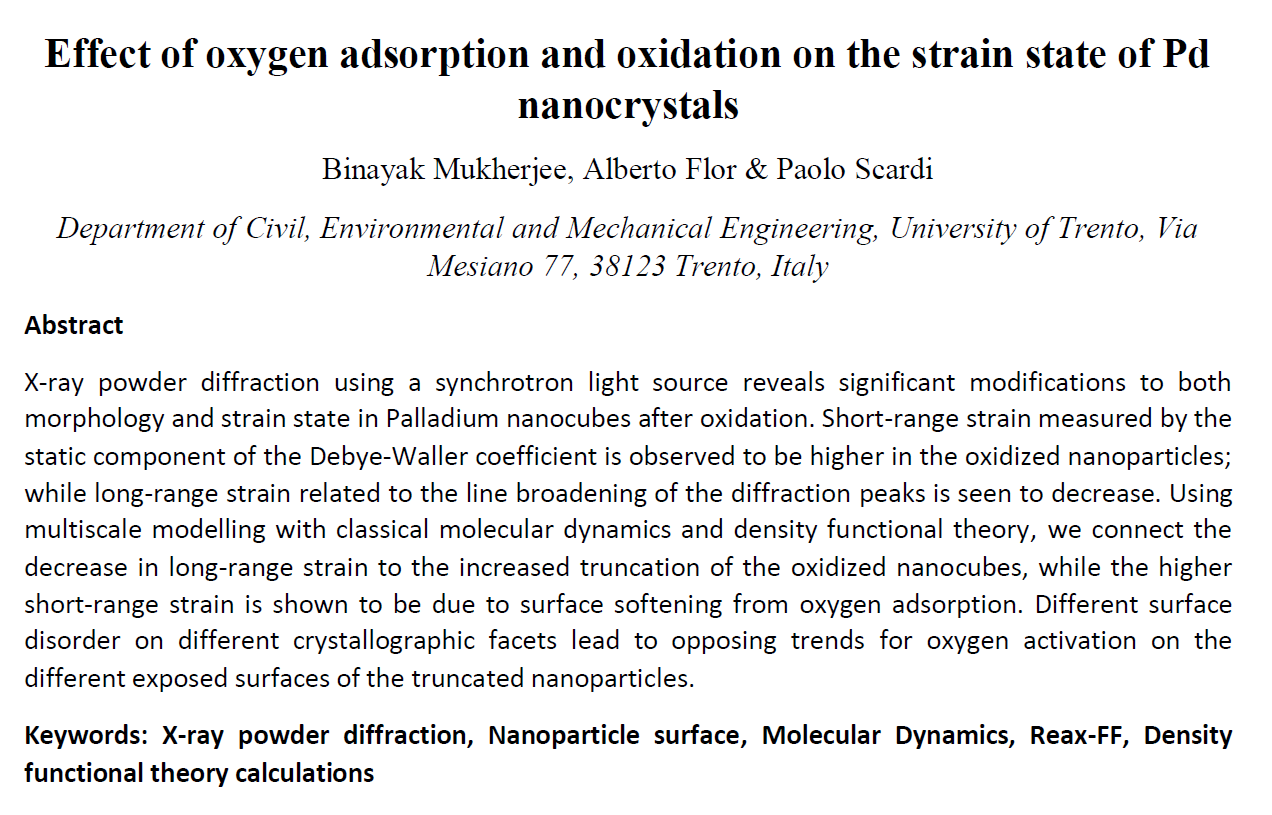
9 Feb, 2021
Large-Area Nanocrystalline Caesium Lead Chloride Thin Films: A Focus on the Exciton Recombination Dynamics / Falsini, Naomi; Calisi, Nicola; Roini, Giammarco; Ristori, Andrea; Biccari, Francesco; Scardi, Paolo; Barri, Chiara; Bollani, Monica; Caporali, Stefano; Vinattier, Anna. - In: NANOMATERIALS. - ISSN 2079-4991. - 11:2(2021), pp. 1-15. https://iris.unitn.it/retrieve/handle/11572/291922/413246/Scardi_nanomaterials-11-00434.pdf

28 Jan, 2021
A new route for caesium lead halide perovskite deposition / Naomi Falsini, Andrea Ristori, Francesco Biccari, Nicola Calisi, Giammarco Roini, Paolo Scardi, Stefano Caporali, Anna Vinattieri Journal of European Optical Society https://www.researchsquare.com/article/rs-135573/v1
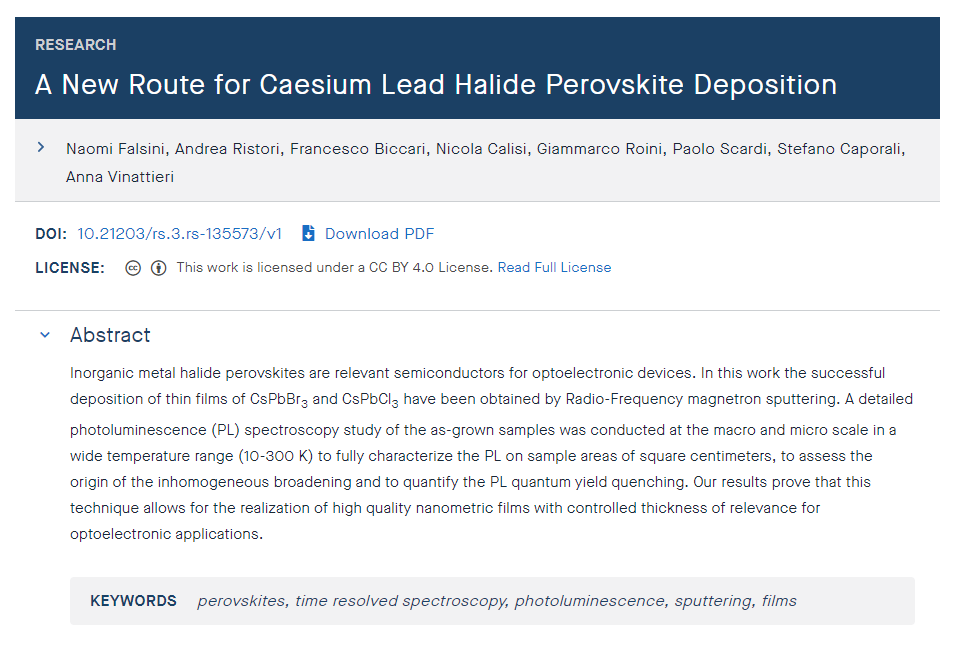
- 3, May 2021
Effect of High-Energy Milling on the Dissolution of Anti-HIV Drug Efavirenz in Different Solvents / Ataollahi, Narges; Broseghini, Marica; Ferreira, Fabio F.; Susana, Alberto; Pizzato, Massimo; Scardi, Paolo. - In: ACS OMEGA. - ISSN 2470-1343. - 6 (2021):19(2021), pp. 12382-12930. http://dx.doi.org/10.1021/acsomega.1c00712
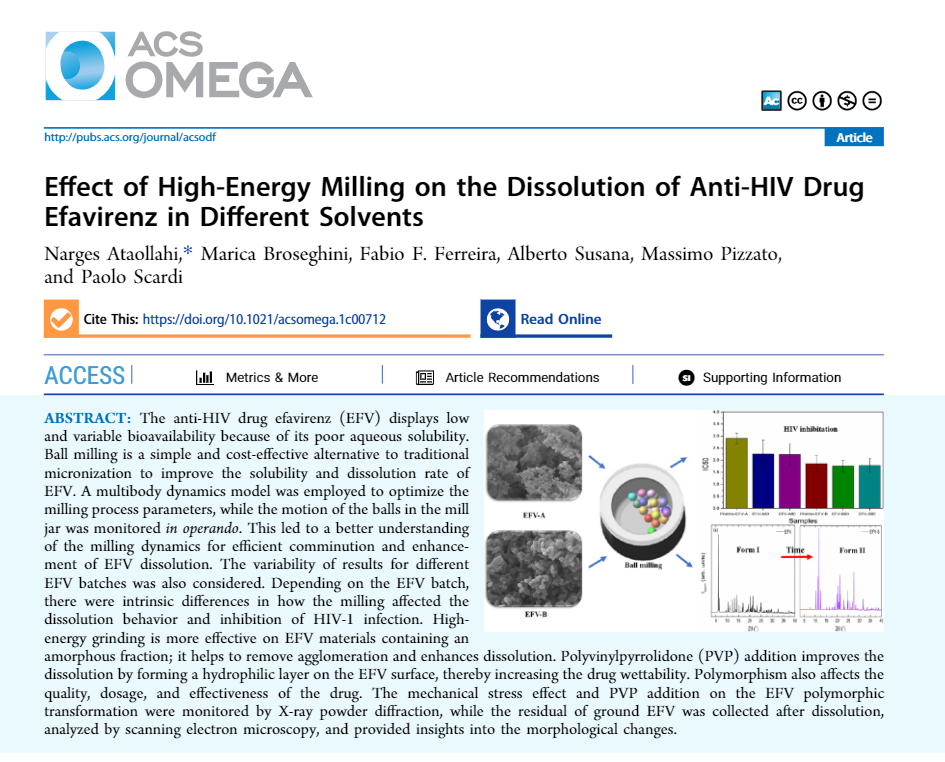
15, Jul 2021
Promising porous Cu2ZnSnS4 electrode composition synthesized by acetate route-based sol-gel process for lithium battery application / Abdah, M. A. A. M.; Rejab, M. R.; Mokhtar, M.; Sopian, K.; Ahmad, A.; Ahmoum, H.; Scardi, P.; Su'ait, M. S.. - In: CERAMICS INTERNATIONAL. - ISSN 0272-8842. - 47:14(2021), pp. 20717-20724. http://dx.doi.org/10.1016/j.ceramint.2021.03.335
